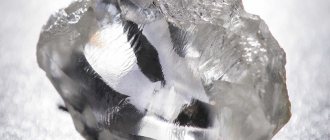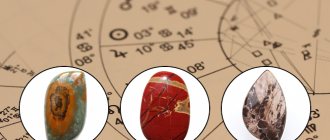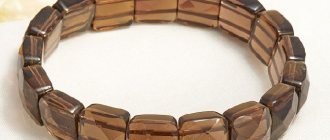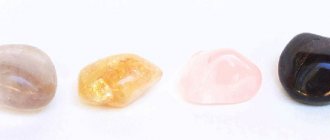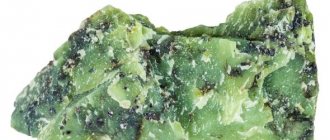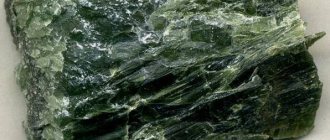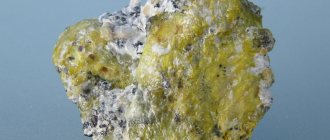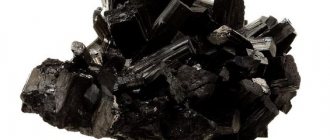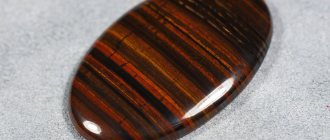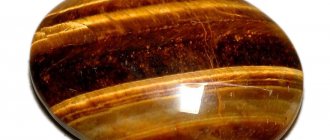Serpentine stone is a natural mineral that is not precious. Rather, it is classified as ornamental and is widely used both for finishing work and in the production of costume jewelry.
The price of the stone is not high, but it looks very impressive due to its unusual coloring, similar to snake skin. Hence the name.
The serpentine has numerous magical and healing properties, which were highly valued in ancient times and are valued today.
An amulet from the Serpentine will protect you from various negativity and help you find peace of mind.
The history of the origin of the stone and the legends and myths associated with it
The origin of the gem is associated with an ancient legend that once upon a time in the Ural Mountains, a snake that lived there, called the Great Stone Snake, rubbed against the mountain to shed its old skin.
The shed skin immediately turned into beautiful stones. This is how a mineral of extraordinary beauty was formed, named Serpentine in honor of the Ancient Serpent.
The first mention of the stone dates back to the 3rd century BC, when it was discovered and widely used in China. Among the American Indians, the mineral was also widespread.
During excavations, various products and decorations made from gemstones are still found, ranging from household utensils to ritual objects.
The serpentine came to European countries only in the 16th century. There it was first used in pharmacy and was called nothing more than pharmaceutical stone.
Due to the possibility of processing, later it began to be used for the manufacture of furniture, cladding, etc. It is still used to this day. Wall clocks, table sets, boxes, chess sets and candlesticks made from gems look very luxurious.
Frames for icons were made from it, walls and floors were lined with it, and monuments were also sculpted. You can still find antique objects and jewelry from Serpentine in museums.
Application
A box made of natural stone will serve as an extraordinary gift for lovers of beauty.
Serpentine is a completely universal mineral. Tabletops, decorations, frames, boxes - you can make anything from a coil. But this rock is also a finishing material. Due to its moisture resistance, it is used for:
- cladding of saunas, baths and swimming pools;
- aquarium decorations;
- decorating bathrooms.
Craftsmen from all over the world use serpentine stone to realize their fantasies. It makes very beautiful figurines, signets, paperweights, and, of course, jewelry. Rings, beads, bracelets, and earrings with serpentinite look no worse than those made from precious stones.
What is it?
Serpentine belongs to the genus of serpentinites and is a magnesium silicate. This is a rock of yellow-green or green color. It is characterized by the presence of dark inclusions and veins, thanks to which it is very similar in color to snake skin.
It is this fact that makes Serpentine a common decorative stone, which is highly valued by jewelers, sculptors, finishers, and designers.
The meaning of the stone and its physical properties
The meaning of the stone is ambiguous. The serpentine is characterized by many magical properties. Previously, it was an integral attribute of magicians and shamans and was considered a dangerous stone, instilling fear in mere mortals. And now the mineral is used in magic, but it does not cause such horror.
Has the following characteristics and physical properties:
- beautiful glassy oily sheen;
- hardness up to 4 units on the Mohs scale;
- The mineral is quite dense. Its density is 2.6 g/cm³;
- good viscosity;
- fibrous, layered or scaly structure;
- heating temperature up to 600 degrees;
- high fire resistance.
It lends itself well to various types of processing, for which it is valued to this day.
The chemical formula of the gem is MgO[(OH)8Si4O10]. It contains Mg, Al, Zn, Mn, Ni, and iron ions.
STRUCTURE
Serpentine pseudomorph of fosterite with white hydrotalcite. Sample size approximately 75 x 60 x 45 mm. Norway, Buskerud province, Mudum municipality, Snarum, Dypingdal Serpentine-magnesite deposit
Serpentine formula Mg6[Si4O10]*(OH)8 or 3MgO 2SiO2 2H2O. Chemical composition: MgO - 43.0%, SiO2 - 44.1%, H2O - 12.9%. The ratios of the components fluctuate somewhat, especially in differences similar to typical colloids, which are richer in water (usually up to 13–17%). Iron oxides FeO, Fe2O3 and nickel NiO are almost always present as impurities.
The crystal structure of all serpentines (including chrysotiles) is to a certain extent similar to the simple two-layer structure of kaolinite. The difference lies primarily in the fact that in serpentines the cations are concentrated in trioctahedral layers, in contrast to the dioctahedral layers in kaolinite packets. Further, the two-layer packets that make up the structure are characterized by the disproportion of trioctahedral “brucite” layers with hexagonal networks of silicon-oxygen tetrahedra. This disproportionality gives rise to the bending of the packets, which can maintain the direction of curvature in the case of uniform polarity in the direction of the vertices of the tetrahedrons, as occurs in chrysotiles, the structure of which turns out to be similar to tubes or rolls. In layered serpentines, the polarity of the networks periodically (in space) reverses, so that the structures alternate stripes composed of packets with differently directed vertices of tetrahedra, placed alternately on different sides of the trioctahedral cationic layer.
The elongation of the fibers coincides with the direction a. In addition to chrysotile with its inherent fibrous structure, all other representatives of serpentines, including antigorite, are found in the form of micro- and cryptocrystalline sheet aggregates. Most of them are colloidal or metacolloidal in nature.
Varieties of Coil
Depending on the content of chemical elements in the gem and the structure of its structure, the following types of mineral can be distinguished:
Antigorite
Being the cheapest variety. Characterized by a yellowish tint.
Noble (Ural) Coil
One of the beautiful varieties, characterized by a rich green color with a whitish tint and many dark inclusions.
Bowenite
Translucent mineral of light green color.
Verdantite
The stone is dark green in color with a high magnesium content, forming black veins.
Williamsite
A bluish gem, the most expensive type.
Ophicalcite
Otherwise called serpentine marble. Characterized by the presence of dark veins.
Porcellophyte
In appearance it resembles porcelain.
Retinolite
The stone is distinguished by a beautiful dark orange color with black tints.
Ricolite
It is considered a poisonous snake with a bright green color.
What is it used for?
Due to the fact that the gem is excellent in cutting, grinding, polishing, has high fire resistance, and a viscous structure, it is used in various fields:
- for the manufacture of decorative items - dishes, boxes, etc.;
- in jewelry making. It is used to make magnificent jewelry;
- walls and floors are finished with mineral;
- he can be found in a Russian bathhouse. It is used for lining the steam room, and also used for finishing stoves with a coil;
- Stone is used to make tiles for cladding bathroom walls.
Where is it used?
According to the jewelry and decorative classification, opite is an ornamental stone, but craftsmen love it.
Jewelers make a full range of jewelry, often combining the stone with jade.
Ophitic bracelet
It has found application among decorators when decorating interiors.
Master stone-cutters use the gem as a source for turning pyramids, balls, eggs, and animal figurines.
Magical properties of the stone
The mineral has strong magical properties, one of which is that it perfectly neutralizes and absorbs various negativity.
It is used as protection against damage and the evil eye, to achieve what you want, it is useful for those who are engaged in self-improvement and spiritual development. The stone develops intuition and clairvoyance, enhances creativity.
The gem can cause irreparable harm to weak people. It is a kind of tempter for those who have a weak will and is capable of strengthening negative character traits, as well as dragging its owner into various types of addictions - alcoholism, gluttony, drug addiction, etc.
But if you manage to gain power over an unpredictable mineral, it will open up incredible opportunities for its owner in all areas of his life. Then the gem will become an indispensable protector and assistant for a person.
It is worth remembering that your stone cannot be given as a gift or even given into the hands of other people, since it completely merges with its owner and absorbs not only his energy, but also his negative message.
Medicinal properties
The coil is widely used in lithotherapy to treat various ailments:
- relief from headaches and migraines;
- speedy recovery after a stroke or heart attack;
- treatment of wounds of various etiologies, fractures, dislocations, bruises, etc.;
- lowering blood pressure;
- for colds and infectious diseases, kidney diseases, gastrointestinal tract, blood problems.
Water infused with Serpentine improves immunity and allows for faster recovery after surgery. It is also believed that the stone can greatly enhance the effects of medications. Thanks to this fact, it is possible to reduce doses of medications that are harmful to health.
Who is suitable according to their zodiac sign?
The horoscope says that the Serpentine is not suitable for all zodiac signs. It is ideal only for Virgos and Capricorns, whom it perfectly removes from stressful situations and helps them find peace of mind and harmony.
The following people can wear the stone without fear: Aries, Taurus, Gemini, Leo, Libra, Aquarius, Scorpio and Sagittarius , but only those who feel inner strength and are able to cope with any temptations, but for Cancers and Pisces the gem is strictly contraindicated.
You can find out more about which stone will suit you according to your zodiac sign on our website in our “Zodiac Signs” section.
Tales of the Malachite Box
If you don't love beautiful stones with selfless love, skip this part. But we can’t help but say something about Bazhov, the singer of the Ural masters, the author of fairy tales.
The collection “Malachite Box” contains the working folklore of the Ural stone cutters, miners, and prospectors. The language in which the collection is written is rich and colorful. And so “ours” that they tried to translate the tales several times, but it didn’t work out very well. Problems in linguistics and culture. Try to translate the nicknames “Stuffy Goat”, “One and a Half Hari”, “Erasko Hurry” into any language. And with us, no matter the nickname, that’s the person’s character.
We recommend: FLUORITE - ore flower with pure magic
Yes, about the coil. There is also a story about him, “A Fragile Twig.” About a young master with golden hands and a keen heart. The Mistress of the Copper Mountain herself helped such people.
“Mityukha is sitting, grinding his berries from merchant’s material, and he himself is still thinking about the same thing: “What kind of cheap local stone can I make such a craft from?”
Suddenly some kind of either a woman’s or a girl’s hand stuck through the window, with a ring on her finger and in her sleeve, and placed a large slab of coil directly on Mityunka’s machine, and on it, like on a tray, was a travel juice.”
The Mistress of the Copper Mountain suggested to the master what could be made from waste material.
“Here I began to figure out which berry would be more suitable, and I myself stared at the place where the hand was. And then she appeared again and placed a burdock leaf on the machine, and on it were three berry branches, bird cherry, cherry and ripe, ripe gooseberries.” The master made a sprig of gooseberries, such that it could be confused with a real one.
Those who continue the work of the talented stone cutter live and create beauty from the simple serpentine stone. Souvenirs and crafts made from snake stone can be seen in jewelry stores. And almost everyone can buy a piece of the skin of the Great Snake.
Talismans and amulets
The gem has powerful energy, so it must be worn very carefully. Amulets, talismans and amulets with Serpentine can be safely worn by people related to medicine, since since ancient times the mineral has been considered a pharmaceutical stone.
It is also recommended to wear:
- businessmen;
- politicians;
- athletes;
- people involved in legal activities.
The stone will not only become an excellent protector, as it has strong protective properties, but will also be able to fully unleash creative potential and help the owner achieve heights in professional activities.
Charms in the form of figurines and interior items will protect your home from uninvited guests with evil intentions, and will also become a wonderful decoration for any room.
Decorations
To create jewelry, samples of coils with ideal characteristics are selected - silky shine, smoothness, unusual pattern. Each stone has an exclusive pattern, so products with it are truly unique.
The best setting for a stone is silver, gold, platinum, tin, copper. The qualities of serpentine are most pronounced in silver cut.
Serpentine is compatible in one piece of jewelry with obsidian and rhodonite - together they create an incredible play of color.
What else is it used for?
The coil is used not only by jewelers and finishers. It is also used in other areas, for example, for landscape design. Garden paths covered with crumbs of such a mineral look very unusual.
It is also used to decorate aquariums. It is also used in firefighting due to its high viscosity, fire resistance and fibrous structure, making heat-resistant chrysotile asbestos from stone that protects workers of the Ministry of Emergency Situations and hot shops.
MORPHOLOGY
The form of isolation is cryptocrystalline masses, fibrous aggregates. Chrysotile asbestos often fills cracks in serpentinites, with its fibers oriented perpendicular to the crack walls.
Composition of the serpentine group:
- Amesite (Amesite) - Mg2Al(SiAl)O5(OH)4
- Antigorite (Antigorite) - (Mg,Fe)3Si2O5(OH)4
- Berthierine - (Fe,Fe,Al,Mg)2-3(Si,Al)2O5(OH)4
- Brindleyite (Brindleyite, nimesite) - (Ni,Mg,Fe)2Al(SiAl)O5(OH)4
- Caryopilite (Karyopilite) - (Mn,Mg,Zn,Fe)3(Si,As)2O5 10(OH,Cl)4
- Chrysotile (Chrysotile) - Mg3(Si2O5)(OH)4
- Cronstedtite (Cronstedtite) - Fe2Fe(SiFe)O5(OH)4
- Fraipontite (Fraypontite) - (Zn,Al)3(Si,Al)2O5(OH)4
- Guidottiite (Guidottiite) - Mn2Fe3+(Fe3+SiO5)(OH)4
- Kellyite (Kellyite) - (Mn,Mg,Al)3(Si,Al)2O5(OH)4
- Lizardite (Lizardite) - Mg3Si2O5(OH)4
- Népouite (Nepouit) - Ni3Si2O5(OH)4
- Pecoraite - Ni3Si2O5(OH)4
Kaolinite – serpentine group:
- Dickite (Dickit) - l2(Si2O5)(OH)4
- Greenalite (Greenalite) - (Fe,Fe)2-3Si2O5(OH)4
- Halloysite - Al2(Si2O5)(OH)4
- Kaolinite (Kaolinite) - Al2(Si2O5)(OH)4
- Manandonite (Manandonite) - Li2Al4(Si2AlB)O10(OH)8
- Nacrite (Nakrit) - Al2(Si2O5)(OH)4
- Odinite - (Fe,Mg,Al,Fe,Ti,Mn)2.4((Si,Al)2O5)(OH)4
.
Stone care
Since the Serpentine tends to quickly accumulate negativity, it is not recommended to wear jewelry with it more than 2 times a week. For the same reason, it is recommended to clean stone products once every two weeks.
This is done using running water, where the pebble is placed. Keep for at least 30 minutes and then dry in the open air.
Store jewelry with a gem in a separate box or casket. It is necessary to protect the stone from falls and mechanical damage.
Price
Serpentine is not a rare mineral, so it is inexpensive. Unprocessed stone costs from 12 to 65 rubles per 1 kg .
The cost of a decorative item made of serpentine is determined by the size of the product and the degree of finishing. The box, for example, has a price range from 550 to 6500 rubles .
The price of jewelry is determined according to the following parameters:
- variety;
- quality and type of processing;
- frame cost.
Most often, the coil is set with a silver-plated jewelry alloy.
Approximate prices for serpentine jewelry:
- earrings - 100–800 rub. ;
- bracelet - 300–800 rub. ;
- rings - 400–800 rub. ;
- nickel silver sets (earrings plus beads) - from 700 rubles. ;
- beads - from 1,100 rubles. ;
- pyramid (50 x 50 mm) - 186 rub. ;
- cabochon (50 x 33 x 5 mm) - 190 rub. ;
- writing instrument “Cube” - RUB 12,779. ;
- chess — 18,920 rub.
How to distinguish from a fake?
Even though the price of a gem is low, the stone is still counterfeited. Cheap plastic crafts are often passed off as it.
To determine whether a stone is natural or not, you need to do the following:
- hold the mineral in your hands. If it heats up quickly, then it's a fake. You can also feel a tingling sensation in your hands from natural stone;
- on a natural gem, the design is involuntary, but on fakes it has a certain consistency;
- Natural stone also differs in weight from plastic, which is much lighter than natural material.
Place of Birth
Serpentine is most often mined in England, Hungary, Germany, India, Italy, New Zealand, the USA and Sweden.
In Russia, serpentine is mined in the Urals. At different fields, coils differ significantly in appearance. For example, the Malyshevsky or Chalinsky coil has mica inclusions, which make the mineral more alive; souvenirs are made from it.
And at the Shabrovskoye and Yuzhno-Shabrovskoye deposits, located in the Chkalovsky region, 20–25 km south of Yekaterinburg, Shabrovsky serpentine is mined. Having a rich green with white stripes, which is most often used as a facing material.
What stones does it go with?
The coil goes well with:
- Jade;
- Obsidian;
- Turquoise;
- Onyx;
- Jet and Agate;
- Jadeite;
- Jasper;
- Lapis lazuli;
- Sarder;
- Rhodonite.
Interesting Facts
In different countries you can learn a lot of interesting things about Serpentine. For example, in China they believe that if you place figurines made of gems in different corners of the room, then there will be no quarrels or disagreements between those living in the house.
In our country in the Urals, in ancient times, people believed in the extraordinary power of the stone and, in order for it to be transmitted to humans, they made fabric from the fibers of the mineral and used it for sewing clothes.
In Mongolia, to this day they believe that the stone can protect even the most poisonous snakes from poison, which is why both adults and children wear amulets with the Serpentine.
In order for the stone to serve its owner properly, immediately after purchasing it, they hold it in their hands for some time to fill it with its energy, then put it aside for a month, but at the same time touch it daily. This way the gem will completely connect with the energy of its owner.
It is also believed that if you put a product made of the mineral on yourself with your right hand during the full moon, its protective power will become most effective.
Favorable time to buy
Astrologers advise purchasing a decorative stone or jewelry on the 18th lunar day, when the energy vibrations of Pluto are soft and calm, which will help you easily come into contact with the gem, convince you of pure intentions and evoke reciprocal sympathy. They begin to wear it on the 4th lunar day, after stroking it daily, holding it in the right hand and tuning in to the vibrations of serpentine.
Magicians and experienced esotericists purchase the mineral during the full moon and put it on immediately.
